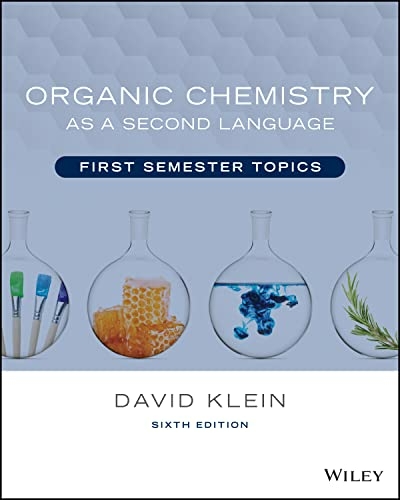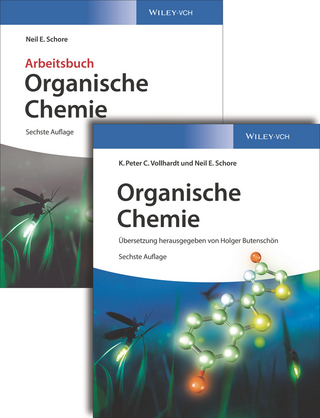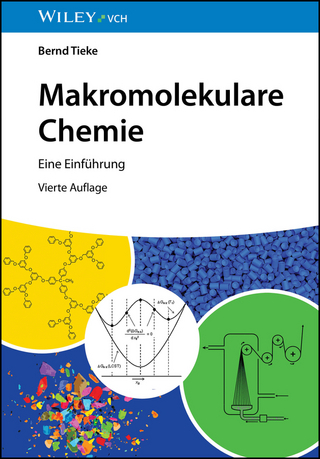
Organic Chemistry as a Second Language
John Wiley & Sons Inc (Verlag)
978-1-119-83709-1 (ISBN)
Covering the initial half of the course, Organic Chemistry as a Second Language: First Semester Topics reviews critical principles and explains their relevance to the rest of the course. Each section provides hands-on exercises and step-by-step explanations to help students fully comprehend classroom lectures and textbook content. Now in the 6th edition, there are approximately 30 new end-of-chapter exercises in each chapter. These new exercises vary in difficulty, starting with exercises that focus on just one skill or concept (called Practice Problems), and continuing with exercises that focus on more than one skill or concept (called Integrated Problems), and concluding with advanced exercises (called Challenge Problems).
There are also author-created, detailed solutions for all new exercises, and these detailed solutions appear in the back of the book.
David Klein is a lecturer at Johns Hopkins University where he teaches Organic and General Chemistry. He is a dynamic and creative teacher and uses analogy to help students grasp difficult topics. Klein's unique informal voice and manner of presentation help students truly master key topics in this course. He is also the author of Organic Chemistry as a Second Language; response to this book has been phenomenal.
Chapter 1 Bond-line Drawings 1
1.1 How to Read Bond-Line Drawings 1
1.2 How to Draw Bond-Line Drawings 4
1.3 Mistakes to Avoid 6
1.4 More Exercises 6
1.5 Identifying Formal Charges 8
1.6 Finding Lone Pairs that Are Not Drawn 11
End-of-Chapter Problems 15
Chapter 2 Resonance 19
2.1 What Is Resonance? 19
2.2 Curved Arrows: The Tools for Drawing Resonance Structures 20
2.3 The Two Commandments 21
2.4 Drawing Good Arrows 24
2.5 Formal Charges in Resonance Structures 26
2.6 Drawing Resonance Structures—Step By Step 29
2.7 Drawing Resonance Structures—By Recognizing Patterns 33
2.8 Assessing the Relative Importance of Resonance Structures 40
End-of-Chapter Problems 45
Chapter 3 Acid–base Reactions 48
3.1 Factor 1—What Atom Is the Charge On? 48
3.2 Factor 2—Resonance 51
3.3 Factor 3—Induction 54
3.4 Factor 4—Orbitals 56
3.5 Ranking the Four Factors 57
3.6 Other Factors 60
3.7 Quantitative Measurement (pKa Values) 61
3.8 Predicting the Position of Equilibrium 61
3.9 Showing a Mechanism 62
End-of-Chapter Problems 64
Chapter 4 Geometry 68
4.1 Orbitals and Hybridization States 68
4.2 Geometry 71
4.3 Lone Pairs 73
End-of-Chapter Problems 75
Chapter 5 Nomenclature 77
5.1 Functional Group 78
5.2 Unsaturation 79
5.3 Naming the Parent Chain 80
5.4 Naming Substituents 83
5.5 Stereoisomerism 85
5.6 Numbering 87
5.7 Common Names 91
5.8 Going from a Name to a Structure 92
End-of-Chapter Problems 92
Chapter 6 Conformations 95
6.1 How to Draw a Newman Projection 95
6.2 Ranking the Stability of Newman Projections 99
6.3 Drawing Chair Conformations 101
6.4 Placing Groups on the Chair 105
6.5 Ring Flipping 108
6.6 Comparing the stability of Chairs 114
6.7 Don’t Be Confused by The Nomenclature 117
End-of-Chapter Problems 117
Chapter 7 Configurations 121
7.1 Locating Chiral Centers 121
7.2 Determining the Configuration of a Chiral Center 124
7.3 Nomenclature 131
7.4 Drawing Enantiomers 134
7.5 Diastereomers 138
7.6 MESO Compounds 139
7.7 Drawing Fischer Projections 141
7.8 Optical Activity 145
End-of-Chapter Problems 146
Chapter 8 Mechanisms 149
8.1 Introduction to Mechanisms 149
8.2 Nucleophiles and Electrophiles 149
8.3 Basicity vs. Nucleophilicity 151
8.4 Arrow-Pushing Patterns for Ionic Mechanisms 153
8.5 Carbocation Rearrangements 158
8.6 Information Contained in a Mechanism 162
End-of-Chapter Problems 164
Chapter 9 Substitution Reactions 168
9.1 The Mechanisms 168
9.2 Factor 1—The Electrophile (Substrate) 170
9.3 Factor 2—The Nucleophile 172
9.4 Factor 3—The Leaving Group 174
9.5 Factor 4—The Solvent 176
9.6 Using All Four Factors 177
9.7 Drawing a Substitution Product and the Mechanism of Its Formation 178
End-of-Chapter Problems 182
Chapter 10 Elimination Reactions 185
10.1 The E2 Mechanism 185
10.2 The Regiochemical Outcome of an E2 Reaction 186
10.3 The Stereochemical Outcome of an E2 Reaction 187
10.4 The E1 Mechanism 190
10.5 The Regiochemical Outcome of an E1 Reaction 192
10.6 The Stereochemical Outcome of an E1 Reaction 192
10.7 Substitution vs. Elimination 193
10.8 Determining the Function of the Reagent 193
10.9 Identifying the Mechanism(s) 195
10.10 Predicting the Products 197
End-of-Chapter Problems 200
Chapter 11 Addition Reactions 204
11.1 Terminology Describing Regiochemistry 204
11.2 Terminology Describing Stereochemistry 206
11.3 Adding H and H 212
11.4 Adding H and X, Markovnikov 215
11.5 Adding H and Br, Anti-Markovnikov 220
11.6 Adding H and OH, Markovnikov 224
11.7 Adding H and OH, Anti-Markovnikov 226
11.8 Synthesis Techniques 230
11.9 Adding Br and Br; Adding Br and OH 236
11.10 Adding OH and OH, Anti 241
11.11 Adding OH and OH, syn 243
11.12 Oxidative Cleavage of an Alkene 245
End-of-Chapter Problems 248
Chapter 12 Alkynes 253
12.1 Structure and Properties of Alkynes 253
12.2 Preparation of Alkynes 255
12.3 Alkylation of Terminal Alkynes 256
12.4 Reduction of Alkynes 258
12.5 Hydration of Alkynes 261
12.6 Keto-Enol Tautomerization 264
12.7 Ozonolysis of Alkynes 269
End-of-Chapter Problems 270
Chapter 13 Alcohols 274
13.1 Naming and Designating Alcohols 274
13.2 Predicting Solubility of Alcohols 275
13.3 Predicting Relative Acidity of Alcohols 276
13.4 Preparing Alcohols: A Review 279
13.5 Preparing Alcohols via Reduction 280
13.6 Preparing Alcohols via Grignard Reactions 286
13.7 Summary of Methods for Preparing Alcohols 289
13.8 Reactions of Alcohols: Substitution and Elimination 290
13.9 Reactions of Alcohols: Oxidation 294
13.10 Converting an Alcohol into an Ether 297
End-of-Chapter Problems 298
Chapter 14 Ethers and Epoxides 300
14.1 Introduction to Ethers 300
14.2 Preparation of Ethers 302
14.3 Reactions of Ethers 304
14.4 Preparation of Epoxides 305
14.5 Ring-Opening Reactions of Epoxides 307
End-of-Chapter Problems 313
Chapter 15 Synthesis 316
15.1 Functional Group Interconversion 316
15.2 Changing the Carbon Skeleton 317
15.3 Two Questions to Ask in Every Synthesis Problem 318
15.4 Retrosynthetic Analysis 320
15.5 Creating Your Own Problems 323
End-of-Chapter Problems 324
Detailed Solutions S- 1
Index I- 1
| Erscheinungsdatum | 29.05.2024 |
|---|---|
| Verlagsort | New York |
| Sprache | englisch |
| Maße | 201 x 252 mm |
| Gewicht | 885 g |
| Themenwelt | Naturwissenschaften ► Chemie ► Organische Chemie |
| ISBN-10 | 1-119-83709-X / 111983709X |
| ISBN-13 | 978-1-119-83709-1 / 9781119837091 |
| Zustand | Neuware |
| Informationen gemäß Produktsicherheitsverordnung (GPSR) | |
| Haben Sie eine Frage zum Produkt? |
aus dem Bereich


